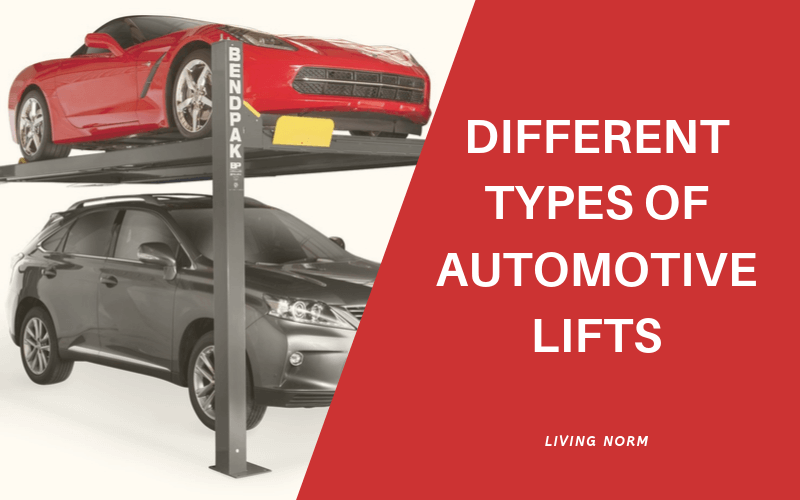
Not all cars have the same weight and dimensions. Therefore, there’s no car lift that can adapt to all car types. The market is full of different car lift models with unique features that best fit in either case.
Some portable and others don’t. Some lift through the car frame and others through the wheels. You can find them in all sizes and shapes you can imagine. Actuated by hydraulic, electric or mechanical systems.
Depending on the weight capacity, vehicle characteristics and frequency of use, you can choose the tool that meets each one of your requirements. Today you’ll know the complete list of all types of automotive lifts currently available in the market.
By studying their features, pros and cons, you’ll be more prepared the next time you decide to buy a new lifting tool. Following a few simple tips, you’ll become a true expert.
What is Automotive Lifts?
They’re tools that serve to lift cars, facilitating the review and repair process. Each automotive lift reaches a different maximum lifting height. Portable models, for example, reach lifting heights up your 2 feet.
In contrast, permanent installation models, such as 2-post and 4-post car lifts, can exceed 75 inches of lifting height.
Most automotive lifts are made of steel. Steel is resistant to shear, bending and compression forces. It can resist the effect of temperature and other external agents.
Most companies of automotive lifts use structural profiles like “I” and “H” types and square tubes to manufacture the frame. The minimum steel thickness for car lifting purposes is between 5-6 mm.
Not all of these tools can lift a car in the same way. Those who do it through the frame, work best with pinch weld vehicles. These were very popular in the mid 90’s. In the early 2000’s, the production of models without pinch weld began.
If you have a too new model, it may not have pinch weld. In that case, it’s better to opt for lifts that lift through the wheels. This kind of tools adapt to all kinds of vehicles. But unfortunately they aren’t portable.
Types of Automotive Lifts
As said before, not all automotive lifts are the same. Therefore, it’s no coincidence that there are so many different types in the market. Maybe you didn’t know, but there are 9 different types of automotive lifts. They’re:
- Portable Automotive Lifts
- Automotive Scissor Lifts
- Column Lifts
- Two-Post Automotive Lifts
- Four-Post Automotive Lifts
- In-Ground Automotive Lifts
- Alignment Automotive Lifts
- Parking Lifts
- Specialty Lifts
Guide to Know Each Type of Automotive Lifts
Below you’ll find a detailed explanation of each type of automotive lift.
Portable Automotive Lifts
Portable models take up less space and you can easily store them in your car’s suitcase. They don’t withstand as much weight as large models, so don’t expect to lift a truck with one of these.
However, most portable models have enough strength to allow you to change a flat tire during an emergency.
Automotive Scissor Lifts
They get this name because they use a scissor-like mechanism to lift. One or more pistons actuate the mechanism, varying the position of the lifting platform. They’re more discreet, because they don’t use columns.
When the mechanism fully collapses, the platform can reach ground level when the base lift is inside a pit.
Column Lifts
These lifts use mobile columns that set under each wheel and then rise to the same height simultaneously. They’re ideal for very heavy vehicles.
Two-Post Automotive Lifts
These models lift vehicles through their frames. Certainly, they’re the best sellers for their high lifting capacity, price and ease of installation.
The lifting system consists basically of two aligned columns joined to two piston-operated lifting arms and a 2-3 HP engine. Both columns are set to the ground through anchor bolts.
Four-Post Automotive Lifts
They work in the same way as their two-post counterparts. However, they lift vehicles through their wheels. In the case of four-post automotive lifts, the columns don’t need to attach to the floor.
Four-post lifts are mobile and you can move them with relative ease from one place to another. Also, they have a greater weight capacity range.
In-Ground Automotive Lifts
They receive this name because you can install them inside the floor. When collapsed, the platform reaches the floor level. They’re very practical, because they allow you to take advantage of extra space for other activities when you aren’t using them.
Compared to other models, installation costs for ground lifts are considerably higher.
Alignment Automotive Lifts
They’re specially designed to perform wheel alignment services on cars. Their runways include mobile plates that allow the wheels to rotate with relative ease. Alignment automotive lifts also receive the name of wheel engaging lifts.
Parking Lifts
Parking lifts allow two cars to park in the same area. Usually, they’re smaller than four-post lifts. In addition, their design prevents leaking fluids the upper car from falling to the ground. That way, the car parked below is safe from stains.
Specialty Lifts
They’re those designed for a specific purpose and whose design doesn’t follow the same standards of commercial models. For example, 6-post lifts commonly used to lift large buses.
Conclusion
Certainly, there’s an ideal automotive lift for each vehicle. Therefore, it’s important to know vehicle features such as weight and dimensions before choosing any model. You should also know the characteristics of the area intended for installation.
From the dimensions to the available power supply. Knowing the pros and cons of each model, you can determine which one is the most appropriate for you. Now that you know all the types of automotive lifts available in the market, it’s up to you to make the final decision.